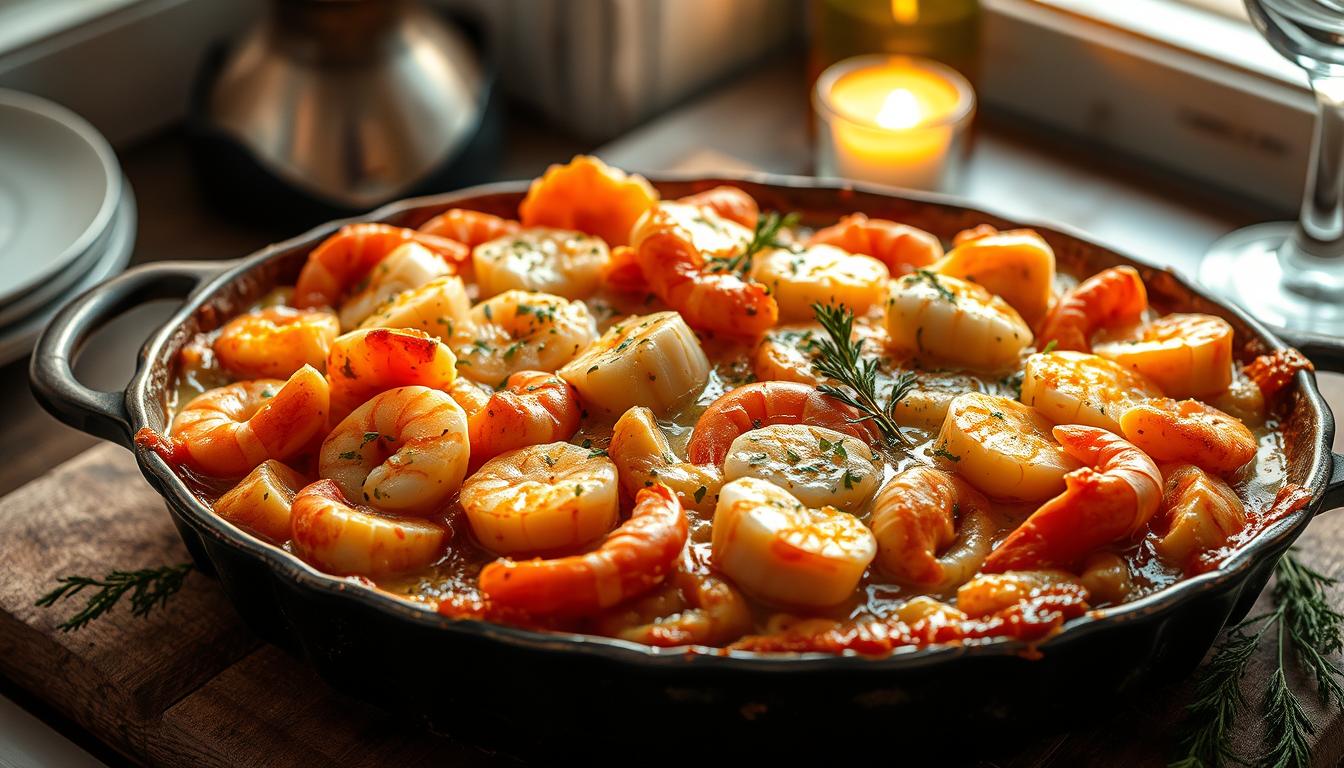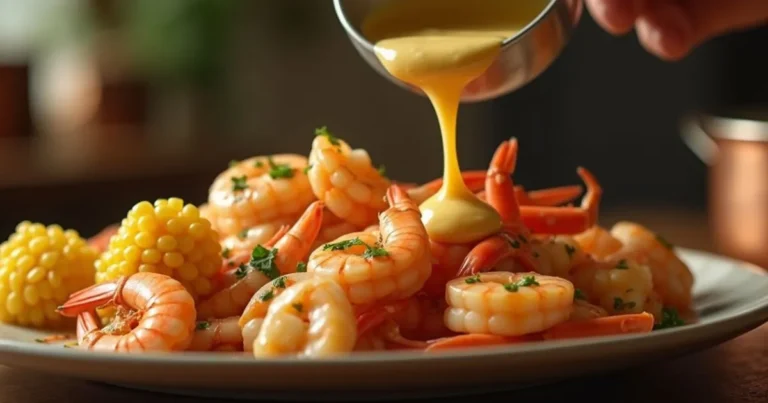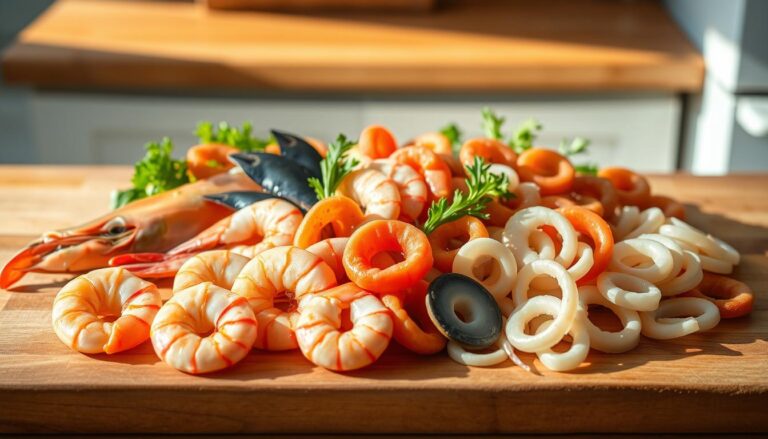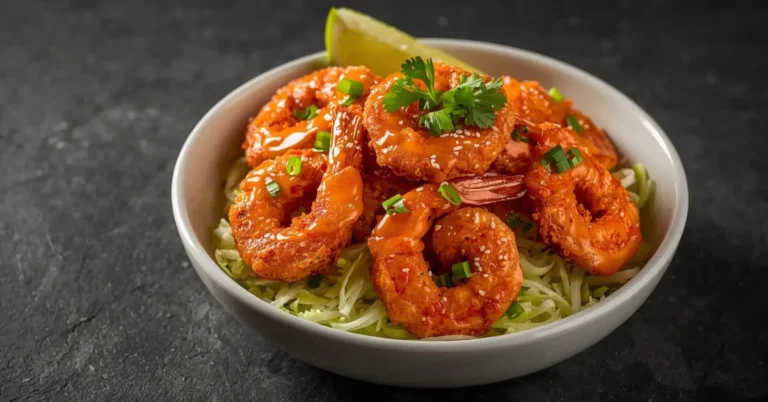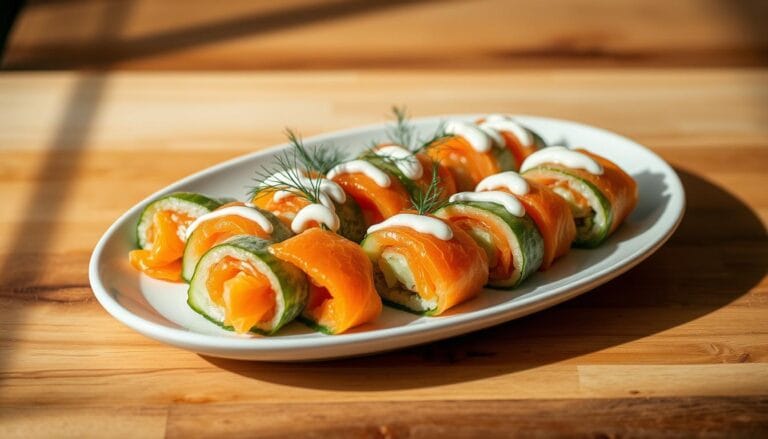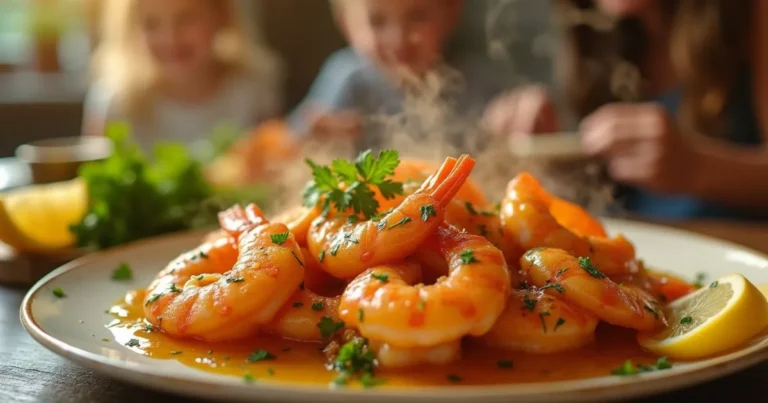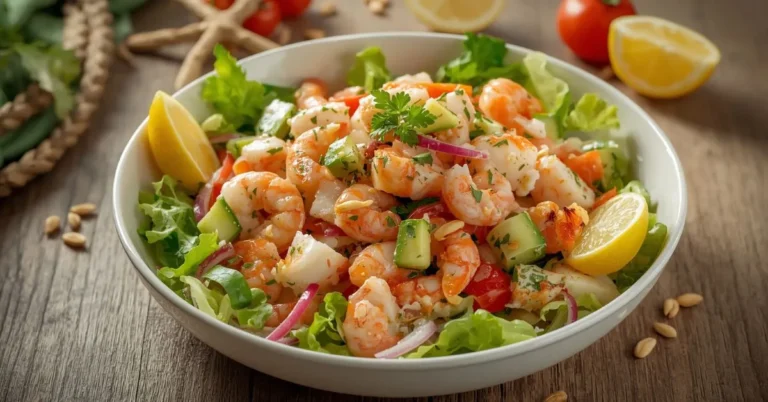How to Make a Perfect Seafood Bake Every Time
Growing up by the coast of New England, seafood was more than food. It was a memory of family and summer fun. The seafood bake is like culinary magic, turning fresh ingredients into a feast that brings everyone together.
Ever wondered how to make the perfect seafood bake? You’re in the right spot. This recipe mixes tasty seafood with colorful veggies and bold flavors. It’s a dish that looks like it came from a restaurant but is easy to make at home. Our three-step guide will help you make a seafood bake that’s sure to impress.
Imagine making a stunning seafood bake in just 30 minutes. It’s filled with juicy shrimp, tender crab, and a mix of vibrant veggies. With the right ingredients and techniques, you’ll make a dish that’s both impressive and delicious.
Key Takeaways
- Master the art of creating a perfect seafood bake in just three simple steps
- Learn how to select and combine the best seafood and vegetable ingredients
- Discover professional tips for seasoning and cooking your seafood bake
- Understand the ideal cooking times and temperatures for optimal results
- Explore versatile seafood recipes that can be customized to your taste
Understanding the Art of Seafood Bake
Seafood bakes are a beloved tradition that brings people together. They are enjoyed in coastal kitchens and at family gatherings. These meals are a great way to enjoy fresh seafood with ease and lots of flavor.
Origins of Seafood Baking
The tradition of seafood baking comes from New England clambakes and Southern seafood boils. These started as community events where fresh seafood was turned into tasty baked dishes. They celebrated local ingredients and brought people together.
- Originated in coastal communities
- Developed from communal cooking traditions
- Reflects regional seafood availability
Benefits of Baking Over Other Cooking Methods
Baking seafood has many benefits for home cooks. A seafood bake with cheese creates a rich, caramelized flavor. The oven’s heat ensures even cooking and keeps fish and shellfish tender.
- Consistent temperature control
- Less mess compared to stovetop cooking
- Allows for easy flavor infusion
Essential Equipment for Perfect Results
To make the perfect seafood bake, you need some key tools. A good baking dish, sheet pan, and meat thermometer are essential for great results.
- Ceramic baking dishes for even heat distribution
- Rimmed sheet pans for easy cleanup
- Instant-read thermometer to check doneness
Pro tip: Always preheat your oven and use a cooking temperature of 375°F for most seafood bakes.
Essential Ingredients for Your Seafood Bake
Creating the perfect seafood bake needs careful ingredient selection. These ingredients must work together for amazing flavor. Your seafood bake with vegetables can turn a simple meal into a memorable dish.
Fresh Seafood Selection Guide
Choosing top-quality seafood is key for a tasty seafood bake. Your protein options can include:
- Large head-on shrimp for maximum flavor
- Snow crab clusters
- Dungeness crab legs
- Tender lobster tails
- Fresh clams and mussels
Seasoning and Spice Combinations
A seafood bake with white wine is even better with the right seasonings. Old Bay Seasoning is a classic, with paprika, celery salt, mustard, and black pepper. Cajun spice blends, with cayenne pepper, garlic powder, and thyme, offer another exciting choice.
Additional Ingredients and Vegetables
Make your seafood bake even better with these ingredients:
- Red potatoes for hearty texture
- Corn on the cob (cut into thirds)
- Sweet onion wedges
- Garlic cloves
- Optional vegetables like bell peppers
Pro tip: Adding a splash of white wine can enhance your seafood bake. It adds depth and moisture, making the flavors more complex and impressive for your guests.
Preparing Your Seafood for Baking
Making a great shrimp and fish casserole starts with careful seafood prep. It’s important to clean and handle the seafood right. This ensures your dish will wow your guests.
Here are the key steps for preparing seafood for baking:
- Clean shrimp by removing the shell and deveining
- Rinse fish fillets under cold water to get rid of debris
- Pat seafood dry with paper towels for a crisp texture
- Check fish fillets for any bones
The type of seafood you choose is key to a successful casserole. Each seafood needs its own prep method:
| Seafood Type | Preparation Method | Cooking Temperature |
|---|---|---|
| Shrimp | Devein, remove shell | 400°F (4-6 minutes) |
| Cod | Remove skin, check for bones | 400°F (12-15 minutes) |
| Salmon | Remove pin bones | 400°F (12-15 minutes) |
Here are some pro tips for the best seafood prep:
- Always buy fresh seafood from trusted sources
- Thaw frozen seafood in the fridge overnight
- Check seafood for any odd smells or colors
By following these tips, you’ll make a shrimp and fish casserole that’s unforgettable. It will highlight the natural flavors of your seafood.
Creating the Perfect Old Bay Butter Sauce
A delicious seafood bake with breadcrumbs needs a great sauce to make it stand out. The Old Bay butter sauce makes your dish go from good to amazing. It adds rich flavors and a coastal twist to your meal.

Making the perfect sauce is all about precision and knowing how to mix flavors. Your seafood bake will be a hit with a butter sauce that perfectly complements the seafood’s taste.
Butter-to-Seasoning Ratios
For the best Old Bay butter sauce, follow these exact amounts:
- 3/4 stick (6 tablespoons) salted butter
- 1 tablespoon Old Bay seasoning
- 3 minced garlic cloves
- 1/2 teaspoon cayenne pepper
Flavor Enhancement Tips
Take your seafood bake to the next level with these tips:
- Add lemon zest for a burst of freshness
- Sprinkle fresh herbs like parsley
- Include a splash of white wine
Storage and Make-Ahead Options
| Storage Method | Duration | Recommended Use |
|---|---|---|
| Refrigeration | 3-4 days | Store in airtight container |
| Freezing | Up to 3 months | Freeze in sealed freezer bag |
Pro tip: Gently reheat the sauce to prevent separation and maintain its smooth, luxurious texture.
Temperature and Timing Guidelines
Getting the perfect seafood bake with lemon and herbs needs careful temperature control and timing. The best baking temperature is between 350°F and 425°F. Cooking times vary depending on the seafood you use.
Here are key temperature guidelines for your seafood bake:
- FDA says to cook seafood to 145°F inside
- Salmon is best at 125°F for moisture
- Halibut cooks well between 130°F and 135°F
- Lobster needs to be 140°F in the tail
Different seafood needs different cooking methods. Fish muscle fibers are much shorter than meat fibers, so they cook faster. Seafood bakes usually take 15-30 minutes, depending on the seafood’s thickness and type.
Pro tip: Always use a reliable meat thermometer to ensure precise cooking temperatures for your seafood bake with lemon and herbs.
Cooking times can change based on your recipe and seafood choice. Shrimp cooks in 5-7 minutes, while fish fillets need 15-20 minutes per inch. Always let your seafood rest for 3-5 minutes after cooking to let juices spread out.
- Thin fillets: 10-15 minutes at 400°F
- Thick fillets: 15-20 minutes at 375°F
- Whole fish: 20 minutes per inch of thickness
By following these temperature and timing tips, you’ll make a tasty seafood bake with lemon and herbs that’s always perfectly cooked.
Seafood Bake Combinations That Work
Creating the perfect seafood bake is all about mixing flavors and ingredients. Whether it’s for a family dinner or a big event, picking the right seafood mix can make your dish stand out.

To make your seafood bake with tomato sauce a hit, choose the right seafood and ingredients. Chefs say it’s key to balance flavors and textures in your mix.
Classic Seafood Combinations
Here are some seafood bake combos that are tried and true:
- Shrimp and white fish
- Crab with scallops
- Salmon and halibut mix
- Lobster paired with mussels
Regional Variations
Seafood bakes vary by region:
- New England: Lobster bakes with rich butter sauces
- Louisiana: Crawfish and shrimp with spicy flavors
- Pacific Northwest: Salmon and rockfish with herbs and tomato sauce
Seasonal Recommendations
Seafood bakes can change with the seasons:
- Spring: Light white fish with fresh herbs
- Summer: Shrimp and scallop mix
- Fall: Hearty salmon and crab
- Winter: Rich seafood bake with tomato sauce
Chefs advise mixing textures and flavors for a seafood bake that wows your guests.
Tips for Achieving Perfect Texture
Getting the perfect texture in a seafood bake is all about precision and technique. You want your dish to be tender, full of flavor, and never tough or dry.
Here are some key strategies for the perfect seafood bake texture:
- Pat seafood dry before cooking to prevent steaming
- Use high heat for quick, even cooking
- Avoid overcrowding the baking dish
- Monitor internal temperature carefully
Timing is everything in a seafood bake. Each type of seafood needs its own cooking method:
| Seafood Type | Cooking Time | Ideal Internal Temperature |
|---|---|---|
| Shrimp | 2-3 minutes per side | 145°F (63°C) |
| Fish Fillets | 3-4 minutes per side | 145°F (63°C) |
| Scallops | 1-2 minutes per side | 145°F (63°C) |
When cooking your seafood bake, remember that residual heat continues cooking your seafood. Take the dish off the heat a bit before it reaches the perfect temperature to avoid overcooking.
Pro tip: Let your seafood rest for a few minutes after cooking. This helps the juices spread evenly, making your seafood bake moist and tender. It will surely impress your guests.
Serving and Presentation Ideas
Creating a memorable seafood bake is more than just cooking. How you serve and present it can make a big difference. A seafood bake with breadcrumbs is a great chance to impress your guests with creative ideas.
Family-Style Serving Suggestions
Family-style serving makes your seafood bake a shared experience. Here are some tips for presentation:
- Use large, rustic baking sheets or cast-iron skillets
- Spread seafood directly on the serving surface
- Encourage sharing and interaction
- Sprinkle seafood bake with breadcrumbs for added texture
Garnishing Techniques
Make your seafood bake stand out with garnishing. It boosts both looks and taste:
- Scatter fresh herbs like parsley or dill
- Add lemon wedges for bright, citrusy notes
- Sprinkle toasted breadcrumbs for crunch
- Drizzle with herb-infused olive oil
Your seafood bake becomes a stunning centerpiece. It sparks conversation and creates lasting memories. The secret is to balance flavors, textures, and looks.
Wine and Beverage Pairings
Choosing the right wine for your seafood bake can make your meal special. White wines are perfect for seafood, adding a nice touch to your dish.
Here are some top picks for a seafood bake with white wine:
- Sauvignon Blanc: A crisp, light wine that pairs well with seafood
- Chardonnay: Great for seafood, especially if it’s unoaked
- Albariño: A Spanish wine that’s perfect for seafood
Think about the seafood in your bake when picking wine. Lighter fish goes well with crisp whites. Richer seafood like lobster or salmon can handle fuller-bodied wines.
Pro tip: The best seafood bake with white wine creates a harmonious balance that enhances both the food and the drink.
Don’t forget about non-alcoholic options. Sparkling water with lemon or lime is a refreshing choice that goes well with seafood.
Trying wines from different regions can make your meal even more exciting. A Muscadet from France or a Pinot Grigio from Italy can add a special touch to your seafood bake.
- Cool climate Sauvignon Blancs offer the most vibrant pairings
- Dry rosé wines provide a versatile alternative
- Sparkling wines like Crémant can add a celebratory touch
The aim is to have a meal where both the seafood and wine are enjoyed. Trust your taste and try different pairings!
Common Mistakes to Avoid
Making the perfect seafood bake with lemon and herbs needs care and focus. Many home cooks face issues that can ruin a meal. Knowing these common mistakes can improve your seafood baking skills and make every dish delicious.
Controlling the temperature is key when cooking seafood. Putting frozen seafood in a hot pan can burn the outside and leave the inside raw. Letting seafood sit at room temperature for about 30 minutes before cooking is a good trick. It helps cook everything evenly and keeps the seafood’s flavors fresh.
Seasoning Challenges
Seasoning is crucial for a great seafood dish. Too much seasoning can hide the seafood’s natural taste, while too little makes it taste bland. Keep your marinating short, about 30 minutes, and use herbs and spices lightly. A food thermometer is your ally to cook perfectly, avoiding both under and overcooking.
Timing and Preparation
Too much in your baking pan can mess up even cooking. Some pieces might not be cooked right, while others are overdone. Each seafood type needs its own cooking method, so do your research. Fresh seafood doesn’t last long, so plan carefully and control your portions to impress your guests.
Frequently Asked Questions:
What is the ideal combination of seafood for a bake?
The perfect seafood bake balances flavors, textures, and cooking times. For best results, combine shellfish like shrimp, mussels, and clams with firmer fish like cod, halibut, or salmon cut into similar-sized chunks. Add lobster tails or crab legs for luxury, ensuring they’re split for even cooking. Aim for at least 3-4 different seafood varieties for complexity. When selecting combinations, consider both cooking times (grouping similar-cooking items) and complementary flavors—oily fish like salmon pairs wonderfully with milder shellfish, creating a balanced flavor profile throughout the dish.
How can I prevent some seafood from overcooking while others remain undercooked?
Timing is crucial for a perfect seafood bake. Start with longer-cooking items like potatoes, corn, and sausage, adding them to the baking vessel first. After about 15 minutes, introduce firm fish and large shellfish like lobster. Wait another 5-7 minutes before adding quick-cooking seafood like shrimp, mussels, and clams. Alternatively, layer ingredients strategically, placing longer-cooking items on the bottom where heat is most intense, and delicate seafood on top. For especially delicate fish, consider wrapping it in parchment or foil packets within the larger bake to control cooking time precisely.
What’s the best cooking liquid for a flavorful seafood bake?
The ideal cooking liquid combines flavor and moisture without overwhelming the natural taste of seafood. Start with a base of white wine, clam juice, or seafood stock for authentic ocean flavor. Add butter for richness and either lemon juice or a splash of vinegar for brightness. Aromatics like garlic, shallots, and herbs (thyme, parsley, bay leaves) infuse depth. For a richer profile, add a touch of cream or coconut milk. The liquid should reach about 1/4 to 1/3 up the sides of your seafood—enough to create steam and flavor but not so much that you’re boiling rather than baking the ingredients.
What are the specific visual indicators and temperature guidelines that signal various seafood varieties have reached their optimal level of doneness while avoiding both undercooking and overcooking?
Different seafood requires different doneness indicators. Fish fillets are done when they flake easily and turn opaque but still appear moist (130-135°F for most fish). Shrimp are perfectly cooked when they curl into a “C” shape (not a tight “O,” which indicates overcooking) and turn pink and opaque (about 120°F). Mussels and clams must open completely—discard any that remain closed after cooking. Lobster and crab turn bright red with opaque, firm meat (135-140°F). Scallops should be just opaque throughout with a slight translucency in the center (125°F). Using an instant-read thermometer provides the most accurate results for larger pieces.
What seasonings complement seafood without overpowering it?
The best seasonings enhance seafood’s natural flavors without masking them. Classic combinations include Old Bay seasoning, Cajun/Creole blends, or Mediterranean herbs like oregano, thyme, and parsley. Fresh garlic, lemon zest, and a small amount of red pepper flakes add dimension without overwhelming. For Asian-inspired bakes, try ginger, lemongrass, and a touch of sesame oil. Remember that seafood absorbs flavors quickly—season with a lighter hand than you would for meat dishes, and always taste before adding salt, as many seafood items (especially shellfish) naturally contain sodium.
How do I incorporate vegetables into my seafood bake for a complete meal?
Select vegetables that complement seafood and have compatible cooking times. Traditional options include corn on the cob (cut into 2-3 inch pieces), baby potatoes, onions, and bell peppers. For quicker-cooking vegetables like asparagus, cherry tomatoes, or zucchini, add them during the last 10-15 minutes of baking. Root vegetables like carrots should be par-boiled first or cut into small pieces. Arrange vegetables strategically, placing denser items on the bottom layer. The vegetables will absorb the flavorful cooking liquid, becoming an integral part of the dish rather than merely a side. For extra flavor, toss vegetables in olive oil, garlic, and herbs before adding them to the bake.
What’s the best cooking vessel for a seafood bake?
The ideal vessel conducts heat evenly while being large enough to prevent overcrowding. A large, heavy-bottomed roasting pan works exceptionally well for oven bakes. Cast iron Dutch ovens or braising pans provide excellent heat retention and can transition from stovetop to oven. For stovetop seafood bakes, a wide, shallow pan with a tight-fitting lid works best. Disposable aluminum roasting pans are convenient for outdoor cooking but may create hot spots—compensate by rotating during cooking. Regardless of vessel choice, avoid overcrowding, which leads to steaming rather than baking. Your ingredients should fit in a single layer with some space for steam circulation.
How do I create a restaurant-quality seafood bake sauce?
A spectacular sauce elevates a good seafood bake to greatness. Start by reducing the cooking liquid after removing the seafood and vegetables. For richness, mount the sauce with cold butter (whisk in small cubes of cold butter one at a time while the sauce is warm but not boiling). Add fresh herbs just before serving. For a classic garlic butter sauce, sauté minced garlic in butter until fragrant, then add cooking liquid, reduce slightly, and finish with lemon juice and parsley. For a creamy variation, add a splash of heavy cream during reduction. The perfect sauce should coat the back of a spoon but remain pourable, allowing you to drizzle it over the plated seafood.
Can I make a seafood bake ahead of time for entertaining?
While complete make-ahead seafood bakes aren’t ideal due to the risk of overcooking, you can prep most components in advance. Clean and prepare all seafood and vegetables up to 8 hours ahead, storing them separately and refrigerated. Pre-measure and combine dry seasonings and prepare any marinade or sauce base. Par-cook potatoes, corn, and other longer-cooking vegetables. When guests arrive, simply assemble and bake. For the most streamlined entertaining, prepare individual foil packets with complete portions that can be baked together but served individually, minimizing last-minute work while ensuring perfect results.
What’s the difference between a New England clambake, a Louisiana seafood boil, and other regional seafood bakes?
Regional seafood bakes differ in ingredients, seasonings, and cooking methods. New England clambakes traditionally feature clams, lobster, corn, and potatoes steamed with seaweed, emphasizing the natural flavors with minimal seasoning beyond butter. Louisiana seafood boils include crawfish, shrimp, andouille sausage, corn, and potatoes with bold Cajun spices (cayenne, paprika, thyme) and often include the distinctive flavor of Old Bay seasoning. Pacific Northwest bakes typically include Dungeness crab, mussels, and local fish with fennel and leeks for herbaceous notes. Mediterranean seafood bakes feature olive oil, tomatoes, white wine, and herbs like oregano and basil. Each regional variation celebrates local ingredients while reflecting cultural flavor preferences
Have you tried this recipe yet? We’d love to hear how it turned out! 🍴
There are no reviews yet. Be the first one to write one.

